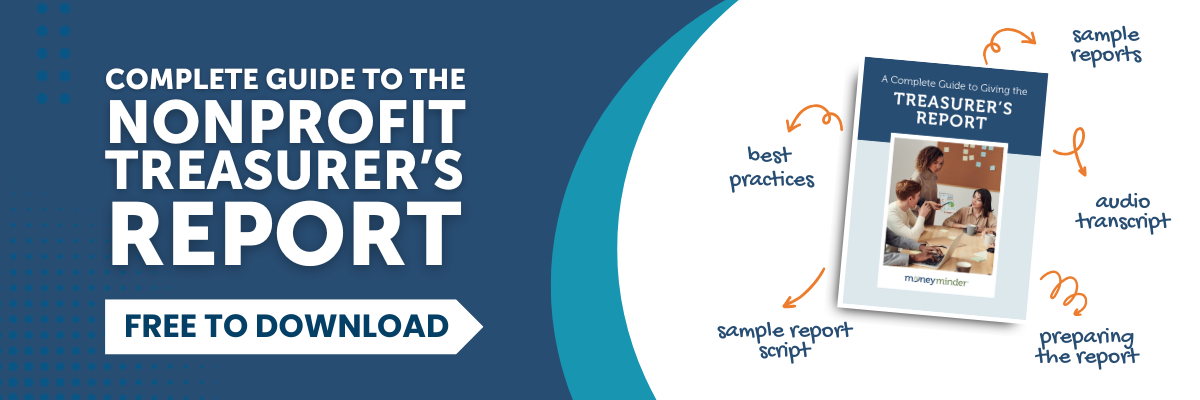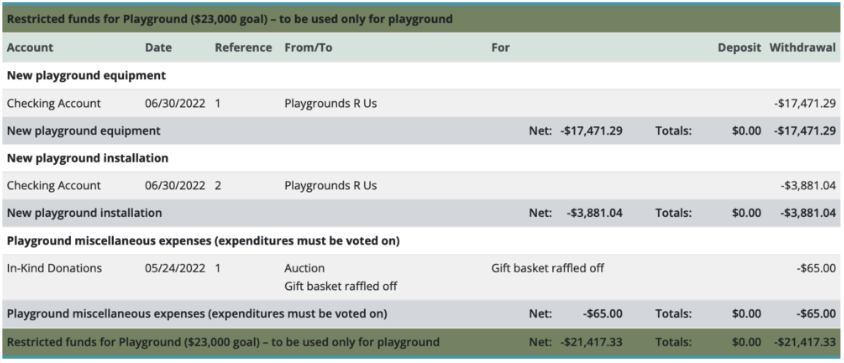What, Why and When to Use 25 Different Nonprofit Reports
Managing finances for a volunteer-run nonprofit can feel overwhelming at times—especially when you open your accounting software to find a long list of unfamiliar reports. What’s the difference between a Balance Sheet and an Income Statement? When should you use a Reconciliation Report? Do you really need to run all of these, and when?
In this guide, we’ll break down the nonprofit financial reports you’ll want to become familiar with, explaining what each one is, why it matters, and when you might use it. Whether you are preparing for a board meeting, wrapping up your financial year, or just trying to stay organized, this reference will help you feel more confident in your financial information and your role as treasurer.
Why are accurate financial reports important for nonprofits?
Financial reports help your nonprofit stay transparent, accountable, and in control—even if you’re a small, volunteer-run group with a modest budget. They show your board and members how funds are being managed, help you make informed decisions, and ensure you’re meeting legal and tax requirements.
25 Types of Nonprofit Reports to Know

1. Balance Sheet
What it is: The balance sheet (sometimes referred to as the Statement of Financial Position) is a traditional nonprofit financial statement that provides a snapshot of your organization’s financial health at a specific point in time.
Use it when: You want to see what your group owns, owes, and has left over (net assets). Useful for board reviews, tax prep, and grant applications.
2. Income & Expense Report
What it is: Displays Actual Income (revenue) and Expense for the period you choose. Shows the actual cash balance at the beginning of the period and the funds available at the end of the period.
Use it when: You want to see cash flow over a specific timeframe (i.e. monthly or quarterly).
3. Income Statement
What it is: Compares Actual Income and Expense for the period you choose, against Budgeted Income and Expense for the year. Traditional format – Income followed by Expense.
Use it when: You’re preparing reports for those more familiar with standard accounting formats.

4. Treasurer’s Report
What it is: Compares Actual Income and Expense for the period you choose, against Budgeted Income and Expense for the year. Shows bank balances as of the start and end dates.
Use it when: You’re giving monthly or quarterly updates to the board or membership.

These reports help you assess how your organization is doing financially over time.
5. Financial Overview
What it is: Displays a summary of activity year-to-date by Budget Heading.
Use it when: You want a quick snapshot of overall financial activity.
6. Budget Report
What it is: The Budget Report shows the Budget for the year. Shows the actual balance carried forward from last year and the budgeted carry forward to next year.
Use it when: You’re reviewing or sharing the organization’s financial plan.
7. Budget Notes Report
What it is: Displays the notes that have been entered for Budget Categories.
Use it when: You need to provide context or explanations for budget lines.
8. Budget Analysis
What it is: The Budget Analysis is an interactive tool Actual Income and Expense against Budgeted Income and Expense while marking budget categories as completed or deferred. Analyze your financial performance year-to-date against your budget and make decisions on future expenditures or fundraising needs.
Use it when: You’re evaluating year-to-date progress and making decisions about spending or fundraising.
9. Historical Comparison
What it is: Compares Actual Income and Expense for the current year against Actual Income and Expense for the previous 3 years. Traditional format – Income followed by Expense.
Use it when: You want to spot trends, like seasonal giving or recurring expenses.
10. Income & Expense Compared to Annual Budget
What it is: Compares Actual Income and Expense for the period you choose, against Budgeted Income and Expense for the year. Shows the actual cash balance at the beginning of the period and the funds available at the end of the period.
Use it when: You want to track how you’re performing against your yearly plan.

11. Deposit Report
What it is: Lists all deposits for the Bank Account you choose, optionally with splits, for the date range you choose. Sort by Date, or Reference #, Memo, or deposit amount.
Use it when: You’re verifying income or preparing for reconciliation.
12. Withdrawal Report
What it is: Lists all withdrawals for the Bank Account you choose, optionally with splits, for the date range you choose. Sort by Date, or Reference #, Memo, or withdrawal amount.
Use it when: You’re checking expenses or looking for a specific payment.
13. Transfer Report
What it is: Displays the transfers that have been recorded during the year.
Use it when: You need a record of internal fund movements between accounts.
14. Reconciliations Report
What it is: Displays detailed information for each bank reconciliation for the Bank Account you choose.
Use it when: You’re double-checking your work or preparing for an audit.

15. Transactions by Heading and Category
What it is: List all Income and Expenses in date order for all Categories in the order they appear in your budget, for the period you choose.
Use it when: You want a full view of financial activity by your budget structure.
16. Transactions by Category
What it is: List all Income and Expenses in date order for all Categories in alphabetical order, for the period you choose.
Use it when: You’re trying to locate something quickly by name.
17. Transactions by Bank Account
What it is: Displays details for all Deposits and Withdrawals for the year by Bank Account.
Use it when: You’re reconciling or reviewing activity by account.
18. Transactions by Heading and Category Compared to Budget
What it is: List all Income and Expenses in date order for all Categories in the order they appear in your budget, for the period you choose. Compare to Annual Budget.
Use it when: You want to see actuals alongside what was planned.
19. Transactions by Category Compared to Budget
What it is: List all Income and Expenses in date order for all Categories in alphabetical order, for the period you choose. Compare to Annual Budget
Use it when: You’re evaluating budget performance by category name.

20. 990-EZ Report
What it is: Provides summary totals to assist in the preparation of the first page of the IRS 990-EZ tax form.
Use it when: You’re preparing your annual IRS return.
21. Annual Report
What it is: This is the Treasurer’s Report spanning the entire year.
Use it when: You’re summarizing finances for the full fiscal year.
22. Audit Report
What it is: Summary report comparing Bank Statement balances to your MoneyMinder balances to ensure that they match.
Use it when: You’re reconciling accounts or preparing for an audit or financial review.

23. Activity Account Balance
What it is: Displays contacts for a given activity account showing the activity account balance and amount due. Allows you to filter by balance and amount due.
Use it when: You need to follow up on payments for events, fundraisers, or programs.
24. Membership Report
What it is: Displays the membership status of contacts and summarizes the amount received by membership level and the total organization dues owed. Allows you to filter by contact tags, date range, membership level, and payment status.
Use it when: You’re reporting on membership levels or tracking renewals.
25. Volunteer Hours Report
What it is: Summarizes logged volunteer hours by contact and event.
Use it when: You want to recognize volunteer contributions or report hours for grants, or to provide documentation for volunteers who need to track hours.

How to Report on Restricted Funds in MoneyMinder
To report on restricted or reserved funds in MoneyMinder, you will want to first make sure that any such funds are clearly labeled in your Budget Category Headings. This helps distinguish those funds from your general operating budget and allows MoneyMinder to display them in reports.
We recommend using the All Transactions by Heading and Category report. This report provides a detailed breakdown of your income and expenses, organized by both the budget heading and category, making it easier to track how restricted funds are used over time.

For a higher-level summary of fund balances without individual transaction details, you might prefer the Treasurer’s Report.

Ready to Simplify Financial Reports for Your Nonprofit?
Whether you’re preparing for a board meeting, tracking funds, analyzing your budget or just trying to stay on top of your group’s finances, MoneyMinder makes it easy. With just a few clicks, you can generate clear, accurate and actionable reports tailored to your nonprofit’s needs—no spreadsheets, non guesswork.
If you’re a volunteer treasurer looking for a better way to manage your organization’s money, give MoneyMinder a try. You’ll spend less time sorting numbers and more time making an impact.
Start your free trial today and see how simple nonprofit finances can be.

 Connect your Venmo account to MoneyMinder PRO to directly download transactions, saving you time and effort. You just review the transactions to ensure they are properly categorized and fill out any required fields.
Connect your Venmo account to MoneyMinder PRO to directly download transactions, saving you time and effort. You just review the transactions to ensure they are properly categorized and fill out any required fields. Connect your Bank, Paypal and Square accounts to MoneyMinder PRO to directly download transactions, saving you time and effort. You just review the transactions to ensure they are properly categorized and fill out any required fields.
Connect your Bank, Paypal and Square accounts to MoneyMinder PRO to directly download transactions, saving you time and effort. You just review the transactions to ensure they are properly categorized and fill out any required fields. Connect your Bank, Paypal and Square accounts to MoneyMinder PRO to directly download transactions, saving you time and effort. You just review the transactions to ensure they are properly categorized and fill out any required fields.
Connect your Bank, Paypal and Square accounts to MoneyMinder PRO to directly download transactions, saving you time and effort. You just review the transactions to ensure they are properly categorized and fill out any required fields. Join It is a membership management service that helps businesses and nonprofits effectively sell, track, and grow their membership.
Join It is a membership management service that helps businesses and nonprofits effectively sell, track, and grow their membership. Connect your Bank, Square and PayPal accounts to MoneyMinder PRO to directly download transactions, saving you time and effort. You just review the transactions to ensure they are properly categorized and fill out any required fields.
Connect your Bank, Square and PayPal accounts to MoneyMinder PRO to directly download transactions, saving you time and effort. You just review the transactions to ensure they are properly categorized and fill out any required fields.